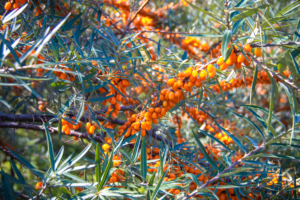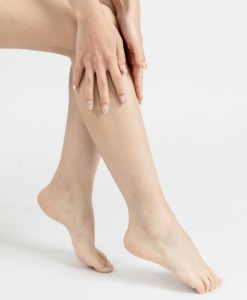As the major components of the outer skin layer are lipids, we can infer that using lipid derivatives will enhance skin conditions. Therefore, plant oils can be used as a source of compounds that may protect skin cells due to their multidirectional activities, including anti-inflammatory, antibacterial, and antioxidants, as well as the source of fatty acids. Sea buckthorn (Hippophae rhamnoides) seed oil has been traditionally used for accelerating wound healing and treating skin diseases such as the first stage of atopic dermatitis. However, it is not widely used in skin protection.
Sea Buckthorn Seeds Oil Effect on Antioxidant System
 Due to the high content of polyphenolic compounds and vitamins, the sea buckthorn extract has been found as an antimicrobial factor, with strong antioxidant activity in in vitro examinations. Moreover, it has been suggested that sea buckthorn seed oil may reduce ROS levels under oxidative conditions by its ability to scavenge free radicals.
Due to the high content of polyphenolic compounds and vitamins, the sea buckthorn extract has been found as an antimicrobial factor, with strong antioxidant activity in in vitro examinations. Moreover, it has been suggested that sea buckthorn seed oil may reduce ROS levels under oxidative conditions by its ability to scavenge free radicals.
This study indicates the effectiveness of the antioxidant actions of sea buckthorn oil in the oxidative conditions found in skin cells exposed to UV radiation. However, in physiological conditions, it is not so unambiguous because by increasing the activity of cytosolic enzymes such as NADPH oxidase and xanthine oxidase, this oil contributes to the intensification of ROS generation. After UV radiation, sea buckthorn oil reduces enzyme activity and produces ROS in fibroblasts. This may result from a stronger fibroblast susceptibility to external factors, including oxidative factors such as UVA and UVB radiation and antioxidative factors in oils, which was also indicated for pomegranate seed oil. It has been suggested that high content of unsaturated acids in plant oils are substrates for cellular oxygenases, which can be a source of oxidation products in skin cells.
Independent of modifications of prooxidative conditions, sea buckthorn oil, promotes increases in antioxidant enzyme activity and non-enzymatic antioxidant levels in control cells and cells treated with UV irradiation. Results of this study partially confirm earlier observations that sea buckthorn oil may enhance antioxidant abilities by promoting glutathione accumulation in the whole animal body in the case of rats treated with this oil. It was also shown that supplementation of rats with compounds of sea buckthorn extracts activates the enzymes superoxide dismutase, catalase, glutathione peroxidase, glutathione reductase, and glutathione S-transferase in animal blood.
However, in this study, sea buckthorn oil shows the tendency to decrease fibroblast Cu and Zn-SOD activity in control and UV-irradiated cells. This may be explained by the sea buckthorn oil’s ability to capture electrons and extinguish the singlet oxygen or superoxide anion that is the main substrate of SOD in the cell cytoplasm. Another important cellular redox regulator is the thioredoxin system consisting of thioredoxin and thioredoxin reductase (TrxR). This expression is diminished in skin cells after UV irradiation and enhanced after sea buckthorn oil treatment of keratinocytes and fibroblasts. Previously it has been shown that this system plays a significant role in the pathogenesis of several diseases. Still, it also participates in cellular protection against toxic compounds, which are reduced by thioredoxin or inhibited by thioredoxin reductase. It has been indicated that sea buckthorn includes high levels of proteins containing thioredoxin domains, preventing the disulfide bond formation in oxidizing environments and stabilizing the tertiary and quaternary structure of proteins. It has also been shown that Trx and TrxR synthesis is induced after exposure to prooxidative factors; this explains the strong positive response of this system to UV irradiation, particularly in fibroblasts. Therefore, the enhanced effectiveness of this system after oil treatment may explain the reduction of oxidative stress in these cells.
Cellular antioxidant responses dependent on proteins are promoted by the transcription factor Nrf2, which is responsible for cytoprotective gene transcription. Under physiological conditions, cytoplasmic Nrf2 is bound to Keap1, and oxidative stress caused by UV radiation was found to diminish Keap1 expression, which prevents Nrf2–Keap1–Cul3 complex formation.
Moreover, high levels of ROS and electrophiles such as 4-HNE may lead to the oxidation of Keap1 cysteine residues, causing a lack of binding and/or dissociation of Nrf2 from the complex which results in its translocation into the nucleus. Nrf2 activation is also demonstrated as its targeted genes-HO-1 expression leads to cellular protection against pro-oxidative conditions. Sea buckthorn oil treatment of UV irradiated skin cells acts in two ways—it supports the cellular antioxidant capacity by activating Nrf2 and, at the same time, affects the expression of proteins strongly related to Nrf2 activation.
The results showing enhanced phospho-Nrf2 translocation to the nucleus despite the increased Keap1 level in the cytoplasm suggest that sea buckthorn oil disrupts the Nrf2–Keap1 complex formation. Moreover, sea buckthorn seed oil decreases UV-induced levels of p21 and p62, reducing the possibility of these proteins creating adducts with Nrf2 or Keap1, thus encouraging Nrf2 inhibition. Keap1 might also create adducts with small antioxidant molecules such as melatonin or GSH, preventing Nrf2-Keap1 binding; however, it does not lead to Keap1 degradation. Melatonin has previously been downregulated in skin cells following UV radiation. In contrast, UV-induced decrease in GSH level, shown in this study, is significantly enhanced due to sea buckthorn oil treatment. These modifications to the activators and inhibitors of the Nrf2 pathway cannot cancel the protective effect of sea buckthorn oil to counteract prooxidative conditions.
Sea Buckthorn Seeds Oil Effect on Lipid Metabolism
The effects of sea buckthorn seed oil on redox balance can directly protect the metabolism of skin cells. Maintaining redox homeostasis is important for the physiological metabolism of lipids, which is important for the proper functioning of cells. Phospholipid protection may be associated with beneficial fatty acids in sea buckthorn oil, influencing the skin cells’ fatty acid profile. The strongest correlation between oil fatty acids and an increase in the cells’ fatty acid level is visible in the case of free fatty acids (FFA) regardless of whether they were control  cells or treated with UV radiation.
cells or treated with UV radiation.
This relationship between the FFA composition of the applied oil and cells might be associated with 24 h incubation with oil when cells could only take up and assimilate FFA. Sea buckthorn oil is rich in palmitoleic acid (16:1), which has been reported to play a role in many metabolic processes, including intracellular lipid-mediated signal transduction, which includes lipid metabolism, and is also responsible for maintaining the fluidity of biological membranes. Palmitoleic acid levels are enhanced in the phospholipid profile of keratinocytes and fibroblasts after sea buckthorn oil treatment; this also causes the reduction of mRNA expression of proinflammatory genes, i.e., TNF-α. Therefore, this oil may affect intracellular signaling based on PI3K/Akt kinase cascades and have anti-inflammatory activity, confirmed by experiments on rats with diabetes.
Moreover, sea buckthorn oil contains a large amount of linoleic and α-linolenic acids, which can enhance the level of phospholipid α-linolenic acid in cells. α-Linolenic acid contained in sea buckthorn oil is a source of eicosanoid prostaglandin E1, a signal precursor that produces antibacterial and cytoprotective extracellular fluids. As shown in this study, sea buckthorn oil added to skin cells enhances the level of these acids in phospholipid and free PUFA fractions. Skin cells phospholipid PUFAs fraction is also enriched in γ-linolenic acid, a precursor of anti-inflammatory eicosanoids, such as the 1-series prostaglandins and 15-hydroxyeicosatrienoic acid (15-HETrE).
It has been previously shown that UV radiation significantly disturbs the metabolism of skin cell membrane phospholipids.
In this study, active compounds in sea buckthorn oil enhance the cell’s antioxidant abilities and prevent lipid peroxidation and enzymatic phospholipid metabolism. Sea buckthorn oil enhances both phospholipid and free PUFA levels in keratinocytes and fibroblasts and increases the ROS level favored by ROS-dependent lipid peroxidation, manifested as oxidative fragmentation with enhanced 4-HNE levels and as oxidative cyclization with enhanced 8-isoprostane levels. Independently of that, one of the main sources of peroxidation products-arachidonic acid (AA), is most enhanced in PUFAs of both skin cell lines, which indicates the huge tributary of this acid from used oil.
As a result of AA peroxidation, increases in the 4-HNE levels can directly act as a signaling molecule or through protein adduct formation, significantly influencing their structure and activity. Enzymes also metabolize Phospholipid AA, among which the most important are phospholipases, including PLA2. Previously, UV radiation significantly increases PLA2 activity, while PLA2 inhibition improves skin conditions. Sea buckthorn oil reveals similar to other plant oils PLA2 inhibition properties, preventing UV-induced lipid metabolism.
Despite the observed decrease in PLA2 activity, the levels of endocannabinoids are increased after using sea buckthorn oil. Anandamide is believed to be a partial or full agonist of the CB1 receptor, depending on tissue and conditions. It is suggested to have low efficacy for CB2 receptors, whereas 2-AG is a full agonist of both CB1 and CB2 receptors.
However, an elevated level of endocannabinoids is accompanied by a down-regulation of cannabinoid receptors. Such response may indicate that redox and inflammatory regulation is independent of the cannabinoid receptors. Moreover, oil-induced changes in endocannabinoid levels may influence the skin neuroendocrine capabilities regulated by UV radiation, leading to disorders in steroid hormones, neuropeptides, and neurotransmitters biosynthesis.
Regardless of the above, it has been shown that a high level of AA delivered to skin cells from sea buckthorn oil may result in increased generation of the 4-series leukotrienes, which have a strong proinflammatory and hyperproliferative effect.
Endocannabinoid levels are enhanced by treating skin cells with sea buckthorn oil, agonists of peroxisome proliferator-activated receptors (PPAR). It is known that PPARs are activated by fatty acids and their derivatives, including lipid peroxidation products like 4-HNE, which act as PPAR-α agonists. PPARs act as modulators of cellular processes, including lipid metabolism, and thus create a lipid signaling network between the cell surface and the nucleus. Enhanced expression of fibroblast PPARs indicates that sea buckthorn seed oil has anti-inflammatory activity. PPAR-α controls the expression of proteins that participate in the inflammatory response.
Therefore enhanced activation of PPAR-α observed in fibroblasts indicates the prevention of NF-κB-dependent inflammation. It has also been shown that anandamide as a ligand of PPAR-α can participate in its anti-inflammatory effect through impaired production of TNF-α. Similarly, enhanced expression of PPAR-γ decreases the expression of TNF-α. Moreover, sea buckthorn ethanolic extract has reduced fat pad mass and prevented weight gain in mice. The extract effectively produced hypoglycemic effects in animals through up-regulating PPAR-γ and PPAR-α gene expression.

Leave A Comment